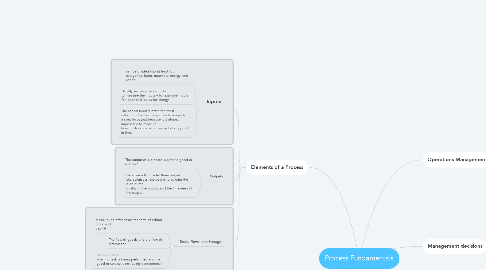
1. Elements of a Process
1.1. Inputs
1.1.1. can be divided into at least four categories: labor, materials, energy, and capital.
1.1.2. Usually we use physical units to measure the inputs – for example, hours for labor and joules for energy.
1.1.3. The capital input is often the most difficult of the four categories to assign to a specific output because it is almost impossible to measure how much capital is consumed at any point in time.
1.2. Outputs
1.2.1. The output of a process is either a good or a service
1.2.2. Here, we will consider three output characteristics: the cost of providing the output, the quality of the output, and the timeliness of the output.
1.3. Tasks, Flows, and Storage
1.3.1. A task quite often takes the form of added labor and capital
1.3.2. The flow of goods and the flow of information.
1.3.3. Storage occurs when no task is being performed and the good or service is not being transported. I
2. Management Complexity
2.1. Variability and uncertainty in the inputs, in the transformation process itself, in the outputs, or in demand increase the complexity of managing an operation.
3. Measuring the Performance of a Process
3.1. Capacity
3.1.1. Capacity is the maximum rate of output from the process and is measured in units of output per unit of time.
3.2. Efficiency
3.2.1. Efficiency is a measure that relates the amount or value of the output of the process to the amount or value of the input.
3.3. Flexibility
3.3.1. This is a measure of how long it would take to change the process so that it could produce a different output, or could use a different set of inputs.
3.4. Quality
3.4.1. Product performance, features, reliability, durability, serviceability, and design aesthetics may all be components of product quality. I
4. Operations Management
4.1. Is about designing, managing, and improving the set of activities that create products and services and deliver them to customers.
5. Management decisions
5.1. Design choices
5.1.1. To start a new operation, the type of process must be selected.
5.2. Ongoing Operating Decisions
5.2.1. Once an operation is up and running, the main management tasks are often order selection, scheduling, setting batch size, and inventory management.
5.3. Process Improvement Decisions
5.3.1. Managers can decide to physically alter the process by changing technology or adding machines or workers.
